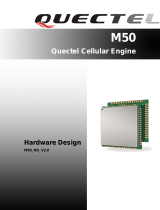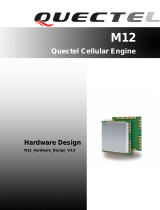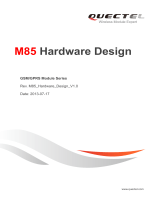Page is loading ...

2 3
click™
BOARD
www.mikroe.com
2. Soldering the headers
3. Plugging the board in
Once you have soldered the headers your
board is ready to be placed into the desired
mikroBUS™ socket. Make sure to align the cut
in the lower-right part of the board with the
markings on the silkscreen at the mikroBUS™
socket. If all the pins are aligned
correctly, push the board
all the way into the socket.
Turn the board upward again. Make sure
to align the headers so that they are
perpendicular to the board, then solder the
pins carefully.
Turn the board upside down so that
the bottom side is facing you upwards.
Place shorter pins of the header into the
appropriate soldering pads.
Before using your click™ board, make sure
to solder 1x8 male headers to both left and
right side of the board. Two 1x8 male headers
are included with the board in the package.
4. Essential features
The underside of GSM3 click™ holds the SIM
card slot. Aside from that the click™ has the
following additional features: audio input/
output connection pad (for microphone
and earphones, can also be used as an FM
antenna). The STM800H module supports
Bluetooth so the click™ has an active 2.4GHz
antenna. A connector for an external GSM
antenna is also provided. Two indication
LEDs signal the operating and network
status of the module.
1
GSM3 click™ carries SIM800H, a quad-band
(850 / 900 / 1800 / 1900MHz) GSM/GPRS
module that transmits voice, sms and data
information. The board communicates with
the target board MCU through the following
mikroBUS™ lines: Tx and Rx (UART), RST
(reset), STA (status indicator), RTS, PWK
(PWRKEY, used to power on/down the module)
and CTS. GSM3 click™ is designed to use 3.3V
and 5V I/O voltage levels.
GSM3 click™
1. Introduction
GSM3 click™ manual
ver 1.01
0100000073834

8. Code examples
MikroElektronika oers free tech support
(www.mikroe.com/support) until the end of
the product’s lifetime, so if something goes
wrong, we’re ready and willing to help!
Once you have done all the necessary
preparations, it’s time to get your click™ board
up and running. We have provided examples
for mikroC™, mikroBasic™ and mikroPascal™
compilers on our Libstock website. Just
download them and you are ready to start.
.com
6. Dimensions
MikroElektronika assumes no responsibility
or liability for any errors or inaccuracies
that may appear in the present document.
Specication and information contained in
the present schematic are subject to change
at any time without notice.
Copyright © 2015 MikroElektronika.
All rights reserved.
mm mils
LENGTH 43 1693
WIDTH 25.4 1000
HEIGHT 8.2 323
AN
RST
CS
SCK
MOSI
MISO
+3.3V
GND
PWM
INT
RX
TX
SCL
SDA
+5V
GND
MIKROBUS DEVICE CONN.
1
5
2
3
7
4
8
LD1
LD2 LD3
R2
100K
+5V
+5V
R1
2K2
GND
+5V
R3
10K
R4
1K5
E2
10uF
GND GND
Vg sm
GND
C2
100nF
GND
GND
C4
100nF
VDD_EXT
GND GND
GND GND
Q1
BC846
R5
1K
GND
R6
100K
GND
7
6
5
4
3
2
1
22
21
20
19
18
17
16
15
14
13
12
11
10
9
8
23
24
25
26
27
28
29
30
31
32
33
34
35
36
37
38
39
40
41
42
43
44
45
46
47
48
49
50
51
52
53
54
55
56
57
58
59
60
61
62
63
64
65
66
67
68
69
70
71
72
73
74
75
76
77
78
79
80
81
82
83
84
85
86
87
88
VBAT
GND
GPIO1
STATUS
BPI_BUSI
GND
VBUS
GND
MIC2P
MIC2N
SPK2N
MIC1N
SPK1N
SIM_DATA
SIM_RST
VSIM
FM_ANT_P
VDDEXT
USB_DM
COL0
COL3
COL2
PCMIN
PCMSYNC
NETLIGHT
ROW4
ROW0
ROW2
ROW1
USB_DP
GND
FM_ANT_N
VRTC
SIM_CLK
SIMPRE
SPK1P
MIC1P
SPK2P
ADC
RESET
PWRKEY
ISINK0
ISINK1
GND
RO W 3
CO L4
CO L1
PW M
G PI O 2
G PI O 3
PCM CLK
PCM O UT
RXD
T XD
RT S
CT S
G ND
BT _ A NT
G ND
G ND
G ND
AN T
G ND
VBAT
G ND
G ND
G ND
G ND
G ND
G ND
G ND
G ND
G ND
G ND
G ND
G ND
G ND
G ND
G ND
SDA
SCL
G ND
G ND
G ND
UA RT _ D C D
UA RT _ D T R
UA RT _ R I
G ND
U1
SIM800H
GND
Q3
BC846
R12
1K
GND
R13
100K
GND
VCC
R14
3K3
Q4
BC846
R15
1K
GND
R16
100K
GND
VCC
R17
3K3
Vgsm
GND
R9 22
R10 22
R11 22
C7
22pF
GND GND
VCC
C1
100nF
E1
10uF
E3
470uF
C3
100nF
GND GND
Vg sm
GND
GND
C5
33pF
C6
10pF
GND
VDD_EXT
GND
STAT
RST
RTS
CTS
TXD
RXD
!RXD
!TXD
!RTS
!CTS
!STAT
RXD
TXD
RTS
CTS
STAT
PWRKEY
!PWRKEY
!STAT
!STAT
SIM_DATA
SIM_RST
FM_ANT_P
!R XD
!T X D
!R T S
!C T S
BT _ A NT
G SM_ A N T
NETLIGHT
NETLIGHT
SIM_CLK
SIMPRE
SIMPRE
GND
!PWRKEY
SIM_VCC
SIM_RST
SIM_DATA
SIM_CLK
GSM_ANT
BT_ANT
E4
10uF
E5
10uF
SIM_VCC
FM_ANT_PMIC+
MIC+
EAR+
EAR+
L1
270nH
GND
MIC-
E6
10uF
MIC-
Q2
BC846
R7
1K
GND
R8
100K
GND
RST
!RST
!RST
D1
C8
1uF
FP1
FERRITE
C9
NP
C10
NP
GND
A1
Rufa
2.4GHz
LEFT
GND
Audio+FM antenna
(earphone)
connection pads
1
2
3
4
HD1
ADJ
5
VOUT
4
GND
3
VIN
2
GND
6
SHDN
1
U2
MCP1826T
1
2
3
4
5
6
7
8 9
10
11
12
13
14
15
16
A1
VCCA
A2
A3
A4
A5
A6
OE
B5
B6
B1
VCCB
B2
B3
B4
GND
TXB0106
U3
TXB0106
R18 0R
GND
+5V
+3.3V
+3.3V
1
2
3
PWRKEY
GSM ANT
SIM800H
SIM_CARD
VCC
GND
RST
CLK
IO
CD2
CD1
U4
1 LEAR - left earphone
2 REAR - rear earphone
3 MIC - microphone
4 GND
HD1
5. Schematic
7. SMD jumper 10. Disclaimer
9. Support
25.4mm / 1000mils
43mm / 1693mils Resolder the onboard zero ohm SMD jumper
to select between 3.3V or 5V I/O voltage levels
(soldered in the 3.3V position by default).
/




